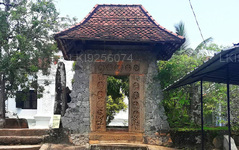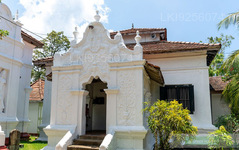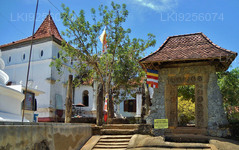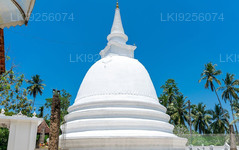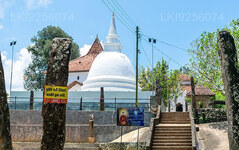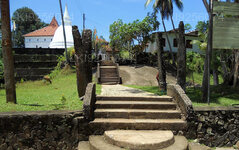
Bentota City
Bentota, a tropical paradise on Sri Lanka's southwest coast, invites you to unwind in its pristine beauty. Discover golden beaches, enjoy water sports on the Bentota River, and visit the vibrant Bentota Bazaar. Luxurious resorts, rich cultural experiences, and scenic landscapes make it an ideal coastal retreat.
Galapatha Raja Maha Viharaya - බෙන්තොට ගලපාත රජමහා විහාරය
Many of the rivers flowing through our country have been named in Pali, as mentioned in our chronicles such as the Mahavamsa, and Culavamsa. Among them is the Bentota Benthara river flowing through the deep south. About 38 miles away from the Colombo-Galle-Matara highway, this river is named in Culavamsa (Part 1) as Bhimathitha. It is derived from the Pali word ‘Bhima’, which means fearful/dreadful, while ‘thitha’ means ferry/port. Legend has it that the river is said to be haunted by a demon lying in its murky depths, ready to prey upon anyone crossing. Old timers living along the banks of this river have recalled how their ancestors, before they crossed the river, invoked the blessings of the guardian deities such as Kataragama and Vishnu for a safe crossing. Close to this Bentota river lies an ancient temple named Benthara Galapatha Raja Maha Vihara. Associated with this river, this temple is also aptly named Bhimathitha Vihara.
Carvings in stoneThe pathway leading to this temple goes through a stone archway off a stone doorway having two upright monolithic pillars on either side, and another two above and below. On those standing pillars are carved elaborate, Nari Latha motifs. These decorative carvings of great aesthetic value date back to the Kandyan period. These fascinating Nari Latha carvings come out of a hoary myth spun around the Rishis of the Himalayas, linked to a fabulous climbing creeper named Nari Latha, which when it blossoms, takes the shape of an enticing damsel. These clusters of flowers are said to have even mesmerised the Rishis, disturbing their meditation. The stone door frame and its standing pillars had been originally installed at the Bentota Udakotuwa Raja Maha Vihara in the Kali Devale. In later years, it was brought to the Galapatha temple.
Rare archaeological findSurpassing them all is a unique archaeological object – Galperanaya (stone water filter), made out of some quality of stone having porous properties to absorb the water filled into it. It is oval in shape, like a basin, having its mouth at the top. Its depth is about 18 inches. There are two small arm-like appendages attached on its left and right hand sides. There are also two oval stone pillars with circular rings lightly carved on them. The Galperanaya is kept under the two arm-like appendages serving as pedestals. The Incumbent of the temple, After about 15-20 minutes, I noticed the outer surface of this stone vessel gradually getting damp. Thereafter drops trickled down into the small basin kept under it. I examined the underside, but there were no incisions made for the water to filter down. Ven. Bentota Assaji disclosed that Dr. Roland de Silva, as Director–General of the Department of Archaeology had visited this temple and been quite amazed to see this marvellous piece. Ven. Assaji said that this Galperanaya was kept exclusively in the Pilimage (image house) to be used for sprinkling ‘pen’ (water) on the flowers offered to the Buddha. He was of the opinion that its age cannot be determined, but it had been kept at this temple from time immemorial when arahats had lived in this monastery.
Stone inscriptionsClose to the stone gateway down on a rock outcrop is etched a line of inscriptions supposed to date back to the reign of Parakramabahu the Great of the 12th Century A.D. or that of the Dambadeniya period of King Parakramabahu I of the 13th century. These inscriptions have been enclosed with a protective metal fence by the Department of Archaeology. The gist of the inscriptions is as follows: In the 31st reign of Parakramabahu king, he had directed a Dravidian chieftain named Mahendra, with the assistance of Dravidians there to build the Galapatha Vihara for which labour, lands, gamvaran and other land donations have been decreed. This noble, a chieftain of high rank and prestige is named Kahambalkulu Mahinda, Dravidian chieftain, thus decreeing lands, gam vasam to the temple, the people and other relatives. (This extract in brief is taken from the Sinhala book titled ‘Bentota Paradisaya’ by Albert Kannangara (2005).
Where a Queen bathedDown by the Bentota river lies another historic landmark in the shape of an oval rock. It is named ‘Nissankamalla Raja Bisawa Isnanaya Kala Istanaya’ (The spot where King Nissankamalla’s Queen had sat on to bathe). There is an inscription here that King Nissankamalla of the 2nd century A.D. had stayed in his travels around Bentota at a place called Maha Pelane. Hence it is locally-named Nissanka Gala.
A Sacred ToothIn the temple premises on a rock outcrop, stands the Dagoba where the Sacred Tooth Relic of Sri Anubuddha Maha Kassyapa Arahat is said to have been enshrined.
In front of the temple premises lies the first image house (Pilimage). At its entrance lies a plain moonstone . The murals are adorned with episodes of Jataka stories, while the the ceiling is studded with paintings of lotus flowers, while on either side sit Bahirawa figures. Inside the shrine room is a reclining Buddha statue. The next image house is also a relic of the past. The original image houses were destroyed by the Portuguese in the 16th century. Here too are seated and recumbent Buddha statues and mural paintings. The Avasa (Monks’ residency), is a commodious one. It has a touch of colonial architecture, having arched windows, and other colonnades. The annual perahera is held on a grand scale in August. It is a great tourist draw, as the temple is located in the heart of the Bentota tourist complex.
Three hundred meters passing the Bentara Bridge, there is a road to the left called Circular Road which goes around the horseshoe shaped river. Five ancient Buddhist temples can be found along this route.
- Udakotuwa Bodhi Sameepa Rajamaha Viharaya
- Vanawasa Rajamaha Viharaya
- Bodhimalu Rajamaha Viharaya
- Galapatha Rajamaha Viharaya
- Bemvehera Gane Rajamaha Viharaya
Although now operating as five different temples, it is believed that these 5 temples had belonged to one large temple complex covering over 6 square kilometers in the the ancient past. Based on the archeological studies, this temple complex has been found to be built by king Devanampiyatissa (250-210 BC) according to Mr. R. Ayrton, Commissioner of Archeology (1912-1913). During the reign of Polonnaruwa kingdom, all the five temples has been under the Galapatha Viharaya.
Maha Kassapa Thero was physically almost identical to Buddha so much that the devotes used to worship Kashyapa Thero thinking it was Buddha and sometimes mistook Buddha for Maha Kashyapa Thero. Therfore the thero decided to live a isolated life in the jungle until the passing away of the Buddha. The Maha Kashyapa Thero lived to be 120 years and passed way in the middle of 3 rocks called Kukkuta Pada and it is said that the rock joined together enclosing the thero’s body. It id said that one of the relatives has held a tooth fallen off of Maha Kashyapa before his death. It is this tooth relic which was brought to Sri Lanka at a later date.
About Galle District
Galle is a city situated on the southwestern tip of Sri Lanka, 119 km from Colombo. Galle is the best example of a fortified city built by Europeans in south and Southeast Asia, showing the interaction between European architectural styles and south Asian traditions. The Galle fort is a world heritage site and the largest remaining fortress in Asia built by European occupiers.
Galle is the best example of a fortified city built by Europeans in south and Southeast Asia, showing the interaction between European architectural styles and south Asian traditions. The Galle fort is a world heritage site and the largest remaining fortress in Asia built by European occupiers.
Galle is a sizeable town, by Sri Lankan standards, and has a population of 91,000, the majority of whom are of Sinhalese ethnicity. There is also a large Sri Lankan Moor minority, particularly in the fort area, which descend from Arab merchants that settled in the ancient port of Galle.
About Southern Province
The Southern Province of Sri Lanka is a small geographic area consisting of the districts of Galle, Matara and Hambantota. Subsistence farming and fishing is the main source of income for the vast majority of the people of this region.
Important landmarks of the Southern Province include the wildlife sanctuaries of the Yala and Udawalawe National Parks, the holy city of Kataragama, and the ancient cities of Tissamaharama, Kirinda and Galle. (Although Galle is an ancient city, almost nothing survives from before the Portuguese invasion.) During the Portuguese period there were two famous Sinhalese poets called Andare who was from Dickwella and Gajaman Nona who was from Denipitiya in Matara District, composing poems on common man.

